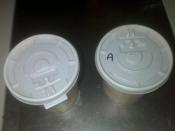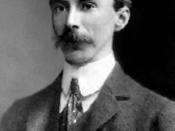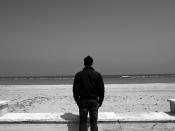OUR KNOWLEDGE OF THE EXTERNAL WORLD
Author: Bertrand Russell
"What is real? ...How do you define real?...If you're talking about what you can feel, what you can smell, what you can taste and see then "real" is simply electrical signals interpreted by your brain..."-Morpheus (The Matrix)
In discussions regarding philosophy, the external world is regarded as everything
used by the five senses that is separate from the human identity. In theory, as the author
states, the external world exists because it is perceived through the senses. "I think it
must be admitted as probable that the immediate objects of sense depend for their
existence upon physiological conditions in ourselves, and that for example, the colored
surfaces we see cease to exist when we shut our eyes." According to this, color is in fact
a product of what the eye sees, and not already in the object. The apple is not red because
the apple is red, but rather because I am looking at it.
When one looks at an object, the
perceiver describes the sight and the recognition of the object and therefore creates the
existence of that object. If saying so, then one must bring to mind what happens when
one looks away from the immediate object. Would the object still exist on itself? Or does
it disappear just because the perceiver is not looking at it, therefore acknowledging its
existence? If the object exists due to the senses proving its reality, then theoretically the
object must cease to exist when it has stopped being perceived. Questions arise whether
the object exists at all since its existence depends on the viewer.
Bertrand Russell separates the idea to know something into two distinct parts.
Perception of an object relies on knowledge of things by acquaintance and knowledge of
things by description. Bertrand Russell uses a table as an example for clarifying this.
Acquaintance of the table results in its characteristics using the primary senses. The table
is long, made out of wood, solid, brown, and polished smoothly. This information is used
to determine that the object exists through what one feels as sensations from the body.
Description of the table is completely separate from the object that is seen. The idea of a
table has a specific notion in the minds of the viewer. It has to have certain standards to
be classified as a table. The table seen by the viewer fits the description of a table, and it
has the elements of what a table might constitute of having. However, the viewer does
not actually know of the table that is seen presently. The table that is seen matches with
the idea of a table and has the characteristics that a table might have. Existence of the
table is now more than just being aware of it, but it is there because one knows also the
idea of the table. A real table in theory, is not the same table that is perceived, but is a
product of Bertrand's "immediate data". An object that is perceived through the
immediate senses, is not the reality of the object, but in essence the information given off
by the object. This is proven if the table was covered in a white sheet. The white sheet
covers the table in its immediate data, masking the knowledge of acquaintance of the
table. When one sees the table covered in a white sheet, the viewer is not bewildered by
it, but rather still perceives it as being a table because of the knowledge of description; in
short the idea of the table. Of course, this all questions if there is even truth in
the existence of matter, and that everything is in fact, an idea of matter.
What a person observes as the external world can be regarded as "immediate
data." "In the world of immediate data nothing is permanent; even the things we regard
as fairly permanent, such as mountains, only become data when we see them, and are not
immediately given as existing at other moments." If the previous statement is true, then
the only thing that can be proven to exist is the existence of the viewer and the viewer's
experiences.
As in-depth Bertrand Russell's ideas are, there is however some fallacies that I
believe can cast doubts on Russell's concept of reality. If there is doubt on the reality of
an object, then there can be theoretically doubt on anything other than oneself. A person
cannot doubt oneself because of Descartes' famous "I think therefore I am." However, it
necessarily does not mean everything else can be doubted and therefore questioned of its
true existence. An example is needed to further emphasize the point. Bernard is walking
from his living room to the kitchen to grab an apple to eat. He opens the refrigerator and
takes one red apple from the bag of apples there and walks back to the living room. A
number of issues come forth from this example. Bernard could not have known for
certain if the apples he thought were in his fridge would be there while walking to the
kitchen. According to Russell, the existence of an object is determined by the senses and
the idea of the object. Since Bernard was in his living room, his senses were not focused
to the apples. This would mean that the apples did not really exist at that time. However,
say that Bernard has not taken an apple for four months from the refrigerator. The apples
are now rotten and void of the healthy red it once had. When Bernard opens the
refrigerator, the apples he sees do not match the idea of apples he had in his mind, nor do
the senses perceive it as the apples he once thought they were. In theory, the apples that
he perceived four months ago should exist as they were when he has perceived it himself.
However, time plays a role in the existence of all objects, self and separate from the
viewer. If the existence of other objects were to be questioned because they are not
perceived by the viewer at that time, then time and growth cannot affect an object unless
it exists independently from the viewer's perception.
Another example would be the process of a seed from germination to full grown
plant. At first, the person planting the seed on the ground perceives the seed as what is at
that moment. Suppose the person leaves and does not come back until five weeks later.
The once small seed has now grown into a full grown plant. The seed should not have
transformed into a plant because the existence of that seed is theoretically dependent of
the viewer's senses and the idea of the seed. The seed grows through time and it is
separate from the world of the viewer. If the seed is separate from the viewer's world of
existence, then that means an object can exist without the perception or the idea of the
object from a person.
Another way to look at some of the doubts regarding Russell's perception theories
is referring to the individual versus to a community of people. The individual is said to
create his or her own reality through his or her own perception. Bluntly said, that means
to Russell that people exist because of other people's perception of them. This contradicts
Descartes' rule of existence in a specific way. "I think therefore I am" can be said by
more than one person. If one man says "I think therefore I am", and another says the
same, then it must be true that both exist without any doubt. If doubt is eliminated from
the existence of both men, then the rule of perception does not apply here because both
men surely exist at the same time although they both perceive each other through their
senses.
Perception itself can be doubted, but the existence of oneself cannot due to
Descartes' rule. Existence can also be defined as having the form to take up space in a
visual and sensory plane. An object exists in reality because it takes up space in a three-
dimensional field. Person A exists in the same plane as Person B who is perceiving the
world through his eyes because Person A and B can both perceive each other. Basically,
if two living things can think therefore existing, and can perceive each other which
solidifies reality for each self, then both must exist at the same time. If that's true, then an
object therefore can exist dependent from the person doing the perceiving of the object.
Perceiver exists, object exists, and so reality is more than just what is perceived through
the senses.


